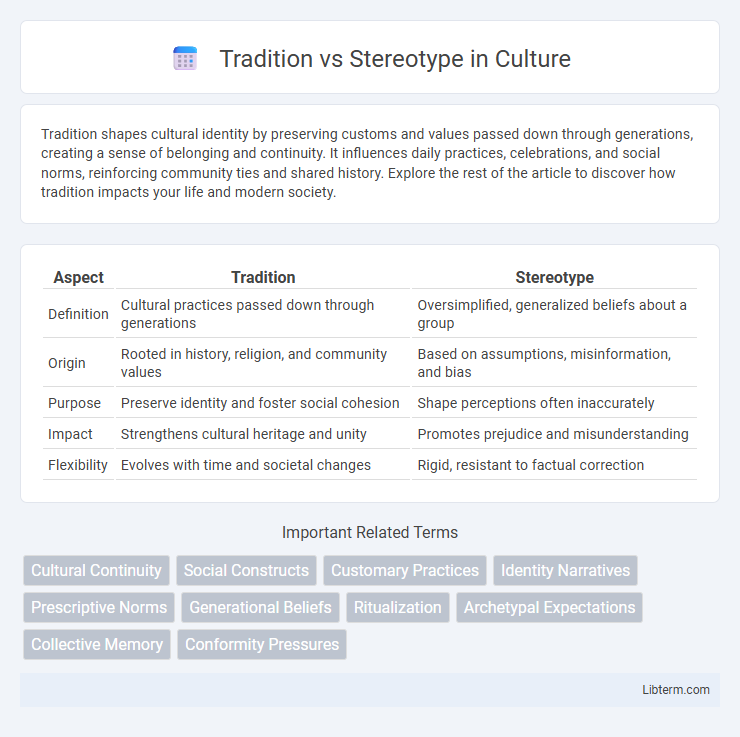Tradition shapes cultural identity by preserving customs and values passed down through generations, creating a sense of belonging and continuity. It influences daily practices, celebrations, and social norms, reinforcing community ties and shared history. Explore the rest of the article to discover how tradition impacts your life and modern society.
Table of Comparison
| Aspect | Tradition | Stereotype |
|---|---|---|
| Definition | Cultural practices passed down through generations | Oversimplified, generalized beliefs about a group |
| Origin | Rooted in history, religion, and community values | Based on assumptions, misinformation, and bias |
| Purpose | Preserve identity and foster social cohesion | Shape perceptions often inaccurately |
| Impact | Strengthens cultural heritage and unity | Promotes prejudice and misunderstanding |
| Flexibility | Evolves with time and societal changes | Rigid, resistant to factual correction |
Understanding Tradition: Roots and Significance
Tradition embodies cultural practices and values passed down through generations, serving as a foundation for community identity and continuity. It reflects collective memory and shared experiences that shape social norms and guide behavior within a group. Understanding tradition requires recognizing its role in preserving heritage while distinguishing it from rigid stereotypes that oversimplify or misrepresent cultural diversity.
What Defines a Stereotype?
A stereotype is a widely held but fixed and oversimplified belief or idea about a particular group of people based on characteristics such as race, gender, or culture. These generalized assumptions often ignore individual differences and reduce complex identities to one-dimensional traits. Unlike traditions, which are established customs passed down through generations and embraced collectively, stereotypes impose limiting perceptions that hinder understanding and perpetuate social biases.
Tradition vs Stereotype: Key Differences
Tradition refers to customs and practices passed down through generations that shape cultural identity and social behavior, emphasizing continuity and shared values. Stereotype involves oversimplified and fixed beliefs about a group, often based on assumptions rather than factual or historical experiences. The key difference lies in tradition fostering cultural preservation and meaning, while stereotypes promote generalized, inaccurate perceptions that can lead to bias.
Cultural Identity: Tradition as Foundation
Tradition serves as the foundation of cultural identity by preserving ancestral customs, values, and rituals that shape community cohesion and individual belonging. Unlike stereotypes, which impose oversimplified and often inaccurate assumptions, traditions offer a rich, authentic narrative that connects generations and fosters a sense of pride. Emphasizing tradition enables the celebration of cultural diversity while resisting reductive labels that undermine unique heritage.
Harmful Effects of Stereotypes
Stereotypes often perpetuate harmful misconceptions, leading to discrimination, social division, and mental health challenges. Rigid stereotypes reduce individuals to oversimplified traits, ignoring cultural diversity and personal identity within traditions. These effects undermine social cohesion and hinder the appreciation of authentic cultural practices.
How Traditions Shape Social Norms
Traditions play a crucial role in shaping social norms by preserving cultural values and practices passed down through generations, establishing expected behaviors within a community. These inherited customs influence identity formation and social cohesion, reinforcing roles, rituals, and collective responsibilities that define group membership. Unlike stereotypes, which rely on oversimplified and often inaccurate assumptions, traditions provide a rich, contextual framework that guides interpersonal interactions and societal expectations.
Breaking Free from Stereotypes
Breaking free from stereotypes requires challenging ingrained societal norms and embracing individuality beyond traditional roles. Empowering diverse perspectives fosters innovation and social progress by dismantling limiting assumptions. Cultivating open-minded communities encourages acceptance and authentic self-expression, reshaping cultural narratives.
Preserving Tradition in a Modern World
Preserving tradition in a modern world involves balancing cultural heritage with contemporary values and technology. Emphasizing authentic practices helps maintain identity while resisting oversimplified stereotypes that reduce rich customs to cliches. Integrating tradition into modern contexts fosters respect and continuity across generations without compromising cultural integrity.
Challenging Stereotypes Through Awareness
Challenging stereotypes through awareness involves actively recognizing and questioning preconceived notions that limit understanding of diverse traditions. Educating individuals about the rich cultural contexts behind traditions fosters empathy and reduces biased judgments. This awareness promotes inclusivity, encouraging societies to celebrate differences rather than conform to narrow stereotypes.
Embracing Tradition Without Reinforcing Stereotypes
Embracing tradition involves honoring cultural practices while critically examining and evolving beyond outdated stereotypes that limit individual identity. Maintaining customs can preserve heritage and community bonds, yet it requires conscious efforts to separate values from generalized assumptions often embedded in traditional narratives. Cultivating awareness and promoting inclusive interpretations enable traditions to thrive without perpetuating harmful stereotypes.
Tradition Infographic

 libterm.com
libterm.com